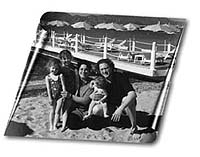"Physics comes in handy anytime, anywhere, because physics teaches you chutzpah." That was one of the opening sentences Jacob Guedalia heard at the Weizmann Institute while on his first interview. "In physics, you step up to the universe and say, 'I know nothing about you, but I'm going to reveal your mysteries and do things that have never been done before,' " states Guedalia. "Being an entrepreneur in the business world is the same."
Bridging the distance between physics and the business world comes naturally to Guedalia, who believes that hi-tech and tradition are complementary, that failure provides the stamina for success, and that the Weizmann Institute provided him with his business skills.
"In the Weizmann Institute's Feinberg Graduate School, I got a chance to see how really excellent people work," he says. He was only one step away from not being accepted at all. "I went completely blank during my interview. The interview lasted three hours instead of the usual half-hour. The professors told me to say something, anything about physics, so they could figure out if I knew the subject at all. It takes chutzpah to study at Weizmann." Finally, Guedalia was informed he should do courses as an external student, and on the basis of his grades, he was later accepted as a graduate student.
Guedalia's M.Sc. in physical optics would later provide a basis for his companies' technology. His objective: to shorten the time it takes to transmit images across networks. In other words, no more twiddling your thumbs as you wait for your computer to download visuals from the Internet. This would enable on-line commerce, and video phones could work over plain old telephone lines. He's accomplishing this by translating the concept on which holograms are based into computer-readable language. (See below.)
The technology of one Guedalia venture was licensed to Microsoft; the second is the Jerusalem-based OLiVR. OLiVR technology gave birth to a union between Guedalia and John Sculley of Live Picture, Inc. [Sculley is former CEO of Pepsico and Apple Computer.]
"I wake up in the morning with an idea, and then set out to see if it works much like a physicist in academia. It's all about creating new worlds," says Guedalia.
And keeping in touch with traditional roots. Guedalia defines himself as orthodox, keeps kosher, and observes shabbat. "No contradiction," he says. "In Yeshiva University, where I did my undergraduate studies, we'd study Gemara half the day and physics the other half. The idea was that both make you complete."
"I definitely think I have more companies in me. I'd love my next company to be in Israel." But isn't America the marketplace for big business? "Israel is second only to the Silicon Valley in technology. In chutzpah, vision and opportunities, Israel is number one."
Holograms: Less is More
If photographic images are based on pictures of images as they are, then holograms are a way to produce a picture based on the diffraction, or breaking up of light into the color spectrum. For example, if you were to take a picture of a cat with your camera, the cat obviously would have to be there for its image to appear on film. However, a hologram of the cat is produced by merely recording the patterns of light diffracted from it. A feature of holography is that only a fraction of the diffraction information is required to reconstruct the complete holographic image. If the same concept could be used in computers, that would mean less data for your computer to store. The "lightweight" (meaning less processing and storage space required) images would then be free to race across your screen.
